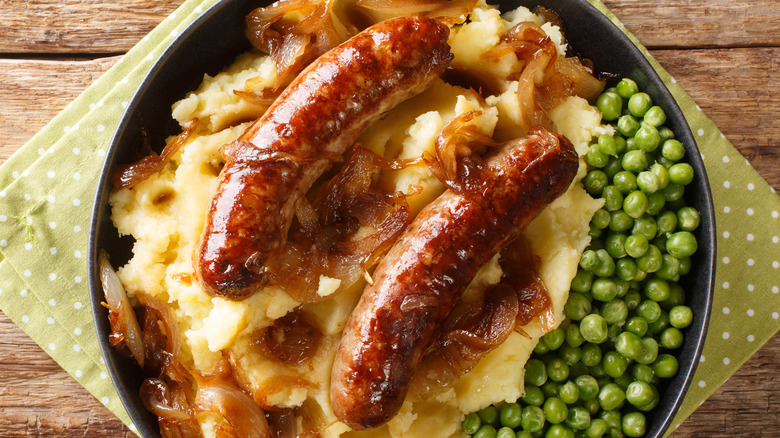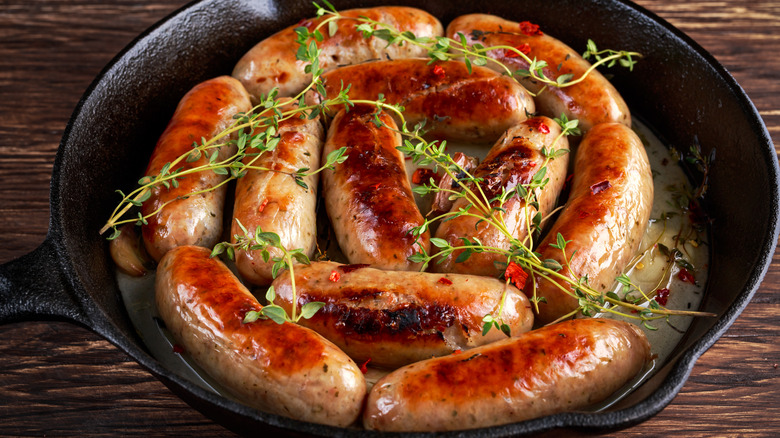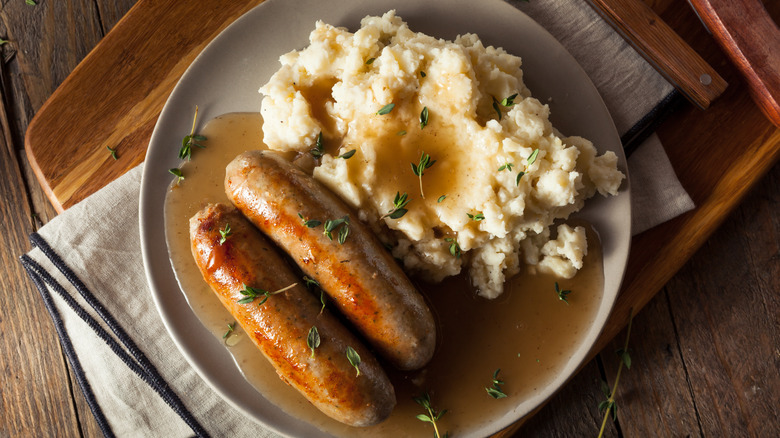What Exactly Is Bangers And Mash Anyway?
Despite the fact that their two countries have a somewhat shared history, and are only an ocean away from one another, Americans just don't understand British food. On one end of the spectrum, there's black pudding, a crispy puck of congealed blood packed with fillers and spice, and jellied eels, which are exactly what they sound like. On the other end entirely, there's the incredibly basic chip butty, a sandwich consisting of nothing more than white bread and fries.
However, if you aren't interested in baked beans on toast, there are British foods worth traveling for. This includes beef Wellington, a beautiful creation that combines puff pastry with juicy beef tenderloin, and sticky toffee pudding, a decadent sponge cake. Another delicious dish that hails from the United Kingdom is bangers and mash. Despite its bold name, bangers and mash is simple fare. You only need two ingredients to make it, but you'll nonetheless find it to be a hearty meal.
World War I and the birth of the banger
People have been packing sausage into links for hundreds of years, but it wasn't until World War I that the name banger ever referred to a single sausage. The global conflict disrupted supply chains, resulting in meat shortages across Europe. In order to meet domestic demand, sausage manufacturers began to cut their links with filler. The result was sausages made artificially fat with a stuffing of bread and water.
Water, when introduced to heat, creates steam. When your sausage is sautéing in the skillet, the steam creates pressure from within its casing. When this pressure proves too great for the lining, your sausage pops, and a seam of spilling meat ruptures from its side. Sausages with more filler are extra prone to popping and can do so with an audible bang, hence the term bangers.
The origins of the term mash are decidedly more simple. It's a colloquial term for mashed potatoes in the United Kingdom.
The basics of bangers and mash
The most common potato preparation used when making bangers and mash involves boiling the potato and, as you might expect, mashing it with butter or another dairy fattener. These buttery mashed potatoes could serve as the base for an excellent plate of classic bangers and mash. Celebrity chef Gordon Ramsay, when making bangers and mash, actually passes over dairy ingredients altogether, instead opting to use olive oil to round out his mashed potatoes. He also covers his mash in homemade onion gravy, which is another traditional feature of the dish. You can watch Ramsay quickly whip up a plate of bangers and mash while his family looks on in a video that is available on his personal YouTube channel.
One of the most common types of sausage used in bangers and mash is Cumberland sausage, which has been churned out by butchers in England's Country of Cumberland for hundreds of years and is noteworthy for the fact that they are chopped, and not minced, therefore improving their texture. If you find yourself with a fine Cumberland on the skillet, and want to avoid the telltale bang of a burst sausage, you can heed the advice that Ramsay offers in the same YouTube video, and poke your sizzling sausage with a toothpick to allow some of the air out.


